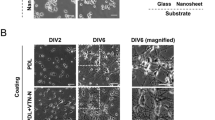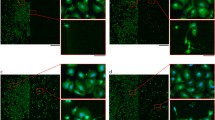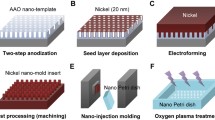Abstract
Nanoporous gold (np-Au) is a promising multifunctional material for neural electrodes. We have previously shown that np-Au nanotopography reduces astrocyte surface coverage (linked to undesirable gliosis) while maintaining high neuronal coverage in a cortical primary neuron-glia co-culture model as long as 2 weeks in vitro. Here, we investigate the potential influence of secreted soluble factors from cells grown on np-Au leading to the cell type-specific surface coverage on conventional tissue culture plastic. We then test the hypothesis that secretion of factors is responsible for inhibiting astrocyte coverage on np-Au. In order to assess whether factors secreted from cells grown on np-Au surfaces reduced surface coverage by astrocytes, we seeded fresh primary rat neuron-glia co-cultures on conventional polystyrene culture dishes, but maintained the cells in conditioned media from co-cultures grown on np-Au surfaces. After 1 week in vitro, a preferential reduction in astrocyte surface coverage was not observed, suggesting that soluble factors are not playing a role. In contrast, 4 h after cell seeding there were a significant number of non-adhered, yet still viable, cells for the cultures on np-Au surfaces. We hypothesize that the non-adherent cells are mainly astrocytes, because: (i) there was no difference in neuronal cell coverage between np-Au and pl-Au for long culture durations and (ii) neurons are post-mitotic and not expected to increase in number upon attaching to the surface. Overall, the results suggest that the np-Au topography leads to preferential neuronal attachment shortly after cell seeding and limits astrocyte-specific np-Au surface coverage at longer culture durations.







Similar content being viewed by others
References
Agarwal, A., and D. E. Bergles. Astrocyte morphology is controlled by neuron-derived FGF. Neuron 83:255–257, 2014.
Arregui, C., S. Carbonetto, and L. McKerracher. Characterization of neural cell adhesion sites: point contacts are the sites of interaction between integrins and the cytoskeleton in PC12 cells. J. Neurosci. 14:6967–6977, 1994.
Biggs, M. J. P., R. G. Richards, and M. J. Dalby. Nanotopographical modification: a regulator of cellular function through focal adhesions. Nanomedicine 6:619–633, 2010.
Blumenthal, N. R., O. Hermanson, B. Heimrich, and V. P. Shastri. Stochastic nanoroughness modulates neuron-astrocyte interactions and function via mechanosensing cation channels. Proc. Natl. Am. Sci. 111:16124–16129, 2014.
Chapman, C. A. R., H. Chen, M. Stamou, J. Biener, M. M. Biener, P. J. Lein, and E. Seker. Nanoporous gold as a neural interface coating: effects of topography, surface chemistry, and feature size. ACS Appl. Mater. Interfaces 7:7093–7100, 2015.
Chapman, C. A. R., P. Daggumati, S. C. Gott, M. P. Rao, and E. Seker. Substrate toporgraphy guides pore morphology evolution in nanoporous gold thin films. Scripta Mater. 110:33–36, 2016.
Daggumati, P., Z. Matharu, L. Wang, and E. Seker. Biofouling-resilient nanoporous gold electrodes for DNA sensing. Anal. Chem. 87:8618–8622, 2015.
Dalby, M. J., N. Gadegaard, and R. O. C. Oreffo. Harnessing nanotopography and integrin-matric interactions to influence stem cell fate. Nat. Mater. 13:558–569, 2014.
Dembo, M., D. Torney, K. Saxman, and D. Hammer. The reaction-limited kinetics of membrane-to-surface adhesion and detachment. Proc. R. Soc. Lond. Ser. B: Biol. Sci. 234:55–83, 1988.
Dorofeeva, T. S., and E. Seker. Electrically-tunable pore morphology in nanoporous gold thin films. Nano Res. 8(7):2188–2198, 2015.
Erlebacher, J., M. J. Aziz, A. Karma, N. Dimitrov, and K. Sieradzki. Evolution of nanoporosity in dealloying. Nature 410:450–453, 2001.
Feng, J., W. Zhao, and J. Wu. A label-free optical sensor based on nanoporous gold arrays for the detection of oligodeoxynucleotides. Biosens. Bioelectron. 30:21–27, 2011.
Gasiorowski, J. Z., S. J. Liliensiek, P. Russel, D. A. Stephan, P. A. Nealey, and C. J. Murphy. Alterations in gene expression of human vascular endothelial cells associated with nanotopographic cues. Biomaterials 31:8882–8888, 2010.
Geiger, B., J. P. Spatz, and A. D. Bershadsky. Environmental sensing through focal adhesions. Nat. Rev. Mol. Cell Bio. 10:21–33, 2009.
Goldberg, M., R. Langer, and X. Jia. Nanostructured materials for applications in drug delivery and tissue engineering. J. Biomater. Sci. Polym. Ed. 18:241–268, 2007.
Gultepe, E., D. Nagesha, S. Sridhar, and M. Amiji. Nanoporous inorganic membranes or coatings for sustained drug delivery in implantable devices. Adv. Drug Del. Rev. 62:305–315, 2010.
Jeon, H., S. Koo, W. M. Reese, P. Loskill, C. P. Grigoropoulos, and K. E. Healy. Directing cell migration and organization via nanocrater-patterned cell-repellent interfaces. Nat. Mater. 14:918–923, 2015.
Jin, H. J., and J. Weissmuller. A material with electrically tunable strength and flow stress. Science 332:1179–1182, 2011.
Kang, K., S. Lee, J. E. Han, J. W. Choi, and M. Song. The complex morphology of reactive astrocytes controlled by fibroblast growth factor signaling. Glia 62:1328–1344, 2014.
Kotov, N. A., J. O. Winter, I. P. Clements, E. Jan, B. P. Timko, S. Campidelli, S. Pathak, A. Mazzatenta, C. M. Lieber, M. Prato, R. V. Bellamkonda, G. A. Silva, N. W. S. Kam, F. Patolsky, and L. Ballerini. Nanomaterials for neural interfaces. Adv. Mater. 21:3970–4004, 2009.
Kurtulus, O., P. Daggumati, and E. Seker. Molecular release from patterned nanoporous gold thin films. Nanoscale 6:7062–7071, 2014.
Li, K., J. Huang, G. Shi, W. Zhang, and L. Jin. A sensitive nanoporous gold-based electrochemical DNA biosensor for Escherichia coli detection. Anal. Lett. 44:2559–2570, 2011.
Mody, N. A., and M. R. King. Influence of Brownian motion on blood platelet flow behavior and adhesive dynamics near a planar wall. Langmuir 23:6321–6328, 2007.
Morgan, J. T., C. J. Murphy, and P. Russell. What do mechanotransduction, Hippo, Wnt, and TGFB have in common? YAP and TAZ as key orchestrating molecules in ocular health and disease. Exp. Eye Res. 115:1–12, 2013.
Patel, J., L. Radhakrishnan, B. Zhao, B. Uppalapati, R. C. Daniels, K. R. Ward, and M. M. Collinson. Electrochemical properties of nanostructured porous gold electrodes in biofouling solutions. Anal. Chem. 85:11610–11618, 2013.
Polikov, V. S., P. A. Tresco, and W. M. Reichert. Response of brain tissue to chronically implanted neural electrodes. J. Neurosci. Methods 148:1–18, 2005.
Popat, K. C., L. Leoni, C. A. Grimes, and T. A. Desai. Influence of engineered titania nanotubular surfaces on bone cells. Biomaterials 28:3188–3197, 2007.
Robinson, D. A. The electrical properties of metal mircoelectrodes. Proc. IEEE 56:1065–1071, 1968.
Santos, G. M., F. Zhao, J. Zeng, and W. Shih. Characterization of nanoporous gold disks for photothermal light harvesting and light-gated molecular release. Nanoscale 6:5718–5724, 2014.
Seker, E., Y. Berdichevsky, M. R. Begley, M. L. Reed, K. J. Staley, and M. L. Yarmush. The fabrication of low-impedance nanoporous gold multiple-electrode arrays for neural electrophysiology studies. Nanotechnology 21:1–7, 2010.
Seker, E., M. L. Reed, and M. R. Begley. Nanoporous gold: fabrication, characterization, and applications. Materials 2:2188–2215, 2009.
Sofroniew, M. V. V., and H. V. Vinters. Astrocytes: biology and pathology. Acta Neuropathol. 119:7–35, 2010.
Solanki, P. R., A. Kaushik, V. V. Agrawal, and B. D. Malhotra. Nanostructured metal oxide-based biosensors. NPG Asia Mater. 3:17–24, 2010.
Venkatesh, H. S., T. B. Johung, V. Caretti, A. Noll, Y. Tang, S. Nagaraja, E. M. Gibson, C. W. Mount, J. Polepalli, S. S. Mitra, P. J. Woo, R. C. Malenka, H. Vogel, M. Bredel, P. Mallick, and M. Monje. Neuronal activity promotes glioma growth through neuroligin-3 secretion. Cell 161:803–816, 2015.
Wagoner, N. J., J. Oh, P. Repovic, and E. N. Benveniste. Interleukin-6 production by astrocytes: autocrine regulation by IL-6 and the soluble IL-6 receptor. J. Neurosci. 19:5236–5244, 1999.
Woolley, A. J., H. A. Desai, and K. J. Otto. Chronic intracortical microelectrode arrays induce non-uniform, depth-related tissue responses. J. Neural Eng. 10:1–11, 2013.
Acknowledgments
We gratefully acknowledge support from UC Lab Fees Research Program Award [12-LR-237197], Research Investments in the Sciences & Engineering (RISE) Award, and National Science Foundation Awards (CBET-1512745 and CBET&DMR-1454426). C. Chapman was supported by a National Science Foundation Graduate Research Fellowship [DGE-1148897] and a predoctoral fellowship from the National Institute of Health [T32-GM008799]. Support was also provided by the CounterACT Program, National Institutes of Health Office of the Director, and the National Institutes of Neurological Disorders and Stroke [U54-NS079202]. H. Chen was supported by a predoctoral fellowship from the National Institute of Environmental Health Sciences [T32-ES007059]. H. Chen and M. Stamou received predoctoral fellowships from the UC Davis Superfund Basic Research Program [P42-ES04699].
Conflict of Interest
E Seker has an issued patent, titled “Nanoporous metal multiple electrode array and method of making same”. C. A. R. Chapman, H. Chen, M. Stamou, and P. J. Lein declare that they have no conflicts of interest.
Ethical Standards
All studies were conducted according to protocols approved by the Institutional Animal Care and Use Committee of the University of California, Davis. No human subjects research was performed in this study.
Author information
Authors and Affiliations
Corresponding author
Additional information
Associate Editor Tejal Desai oversaw the review of this article.
Dr. Erkin Şeker joined the Department of Electrical and Computer Engineering at UC Davis in 2011. He received his PhD degree in Electrical Engineering from the University of Virginia (UVA) in 2007, where he developed techniques to control mechanical and morphological properties of nanoporous gold. During his postdoctoral appointment in the Department of Chemistry at UVA he investigated material-biomolecule interactions and developed microfluidic flow control schemes. Between 2009 and 2011, as a research associate at the Center for Engineering in Medicine at Harvard Medical School, he developed multiple electrode arrays for neural electrophysiology applications and spearheaded the development of microsystems for monitoring transcriptional and secretory dynamics at a cellular-level in the context of metabolic dysregulation. At UC Davis, he is leading the interdisciplinary Multifunctional Nanoporous Metals research group with the overarching goal of understanding and controlling nanostructured material properties and their interaction with biological systems to develop effective biomedical tools for both basic and clinical applications. He is the recipient of Fund for Medical Discovery Award from Massachusetts General Hospital and a NSF CAREER Award. He served as an Associate Scientific Advisor for Science Translational Medicine journal and was selected to participate in National Academy of Engineering’s Annual Frontiers of Engineering Education Symposium in 2014.
This article is part of the 2016 Young Innovators Issue.

Rights and permissions
About this article
Cite this article
Chapman, C.A.R., Chen, H., Stamou, M. et al. Mechanisms of Reduced Astrocyte Surface Coverage in Cortical Neuron-Glia Co-cultures on Nanoporous Gold Surfaces. Cel. Mol. Bioeng. 9, 433–442 (2016). https://doi.org/10.1007/s12195-016-0449-4
Received:
Accepted:
Published:
Issue Date:
DOI: https://doi.org/10.1007/s12195-016-0449-4




